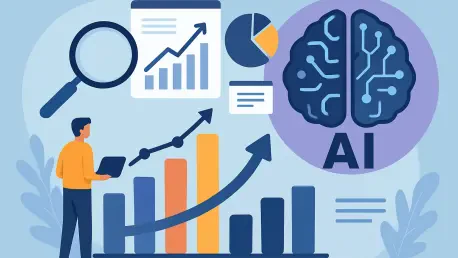In the fast-evolving world of IT operations, the observability market stands out as a critical arena, with its value projected to soar to $14.2 billion by 2028, reflecting the urgent need for visibility into increasingly intricate systems like hybrid and cloud-native environments. As organizations grapple with sprawling tech stacks that span multiple platforms, the demand for tools capable of dissecting telemetry data—such as logs, metrics, events, and traces—has skyrocketed. However, with over 40 vendors crowding this space, the landscape is saturated, creating a challenging environment where differentiation is both vital and elusive. This intense competition breeds rapid innovation but also fuels buyer frustration with escalating costs and complex platforms. Amidst this chaos, artificial intelligence (AI) has emerged as a transformative force, offering smarter, automated solutions that promise to redefine how observability tools function. This article explores the pivotal role AI plays in cutting through the noise of this competitive market, addressing key challenges, and driving the future of IT operations with cutting-edge capabilities.
Navigating a Saturated Market
The observability sector is marked by fierce competition, with a multitude of vendors striving to capture the attention of organizations desperate for system visibility. A recent Gartner Magic Quadrant report had to limit its evaluation to just 20 players, sidelining other capable contenders, which underscores the sheer density of this market. This overcrowding often results in a barrage of offerings that can overwhelm buyers, fostering skepticism about which solutions genuinely deliver value. The pressure to innovate is relentless, as vendors must continuously push boundaries to avoid blending into the background. In such a noisy environment, standing out requires more than just incremental improvements; it demands a paradigm shift in how observability is approached. AI has become a linchpin in this struggle, providing vendors with the means to offer distinctive features that address the sophisticated needs of modern IT landscapes, setting the stage for a deeper transformation in how system performance and reliability are monitored.
Beyond the challenge of market saturation, the underlying driver of this sector’s growth is the escalating complexity of IT environments that span hybrid, multi-cloud, and cloud-native architectures. Traditional monitoring tools fall short in these dynamic settings, unable to provide the comprehensive insights needed to preempt and resolve issues. Full-stack observability, which integrates disparate data sources into a unified view, has become the new benchmark for effectiveness. AI plays a crucial role here by enabling platforms to correlate vast amounts of telemetry data, delivering actionable intelligence that helps IT teams pinpoint root causes swiftly. This shift from reactive to proactive management is what separates leading vendors from the pack. By leveraging AI, these platforms not only enhance visibility but also empower organizations to navigate the intricacies of their systems with greater confidence, reducing downtime and ensuring operational resilience in a landscape where every second of disruption can be costly.
AI as a Core Driver of Innovation
Artificial intelligence, alongside machine learning (ML), has transcended the realm of buzzwords to become an indispensable component of observability platforms. These technologies enable tools to detect anomalies in real time, often identifying potential problems before they escalate into full-blown crises that disrupt operations. Predictive alerting, powered by AI, allows IT teams to stay ahead of issues, while automated incident correlation minimizes the manual effort required to diagnose and address faults. Such capabilities significantly reduce mean time to resolution (MTTR), a critical metric for any organization aiming to maintain seamless service delivery. As IT environments grow more intricate with diverse data streams, the ability of AI to sift through noise and highlight critical insights becomes a game-changer, ensuring that teams focus on what truly matters rather than getting bogged down by irrelevant alerts or data overload.
Furthermore, AI’s integration into observability aligns closely with the broader trend of AIOps (AI for IT Operations), signaling a future where intelligent automation underpins every facet of IT management. Gartner has pointed out that advanced AI features, such as deterministic analysis for mapping service dependencies and monitoring outputs from generative AI applications, are gaining momentum. These innovations reflect a shift toward predictive and self-healing systems that not only react to issues but anticipate and mitigate them autonomously. This evolution is reshaping expectations, as buyers now demand platforms that offer more than static visibility—they seek solutions that learn, adapt, and optimize over time. Vendors embedding AI at the core of their offerings are thus better positioned to meet these expectations, driving a new era of operational efficiency where human intervention is minimized, and system reliability is maximized through continuous, intelligent oversight.
Addressing Cost and Complexity Challenges
One of the most pressing concerns in the observability market is the rising cost associated with managing ever-growing volumes of telemetry data, leading to what Gartner describes as cost fatigue among buyers. As vendors expand their feature sets to stay competitive, the total cost of ownership often balloons, prompting organizations to scrutinize pricing models with greater intensity. AI offers a compelling solution by powering cost optimization features such as tiered storage options and granular data retention policies. These tools allow businesses to control expenses by prioritizing critical data and discarding redundant or low-value information, ensuring that budgets are aligned with actual needs. This approach not only alleviates financial strain but also builds trust with buyers who value transparency and efficiency, making AI a vital asset for vendors aiming to address one of the market’s most persistent pain points.
Equally challenging is the complexity of observability platforms, which can overwhelm IT teams with sprawling feature sets and steep learning curves. As tools become more sophisticated, the risk of underutilization grows, diminishing the return on investment. AI-driven automation tackles this issue by simplifying interactions with these platforms, prioritizing key insights, and streamlining workflows to reduce cognitive load on users. For instance, automated dashboards and intelligent recommendations can guide teams to critical issues without requiring deep technical expertise. This democratization of powerful tools ensures that even organizations with limited resources can extract maximum value from their investments. By cutting through the clutter of complex interfaces and processes, AI enhances usability, making observability solutions more accessible and effective across diverse teams, thereby addressing a significant barrier to adoption in a market where user experience can make or break a vendor’s success.
Enhancing DevOps and Interoperability with AI
Integration with DevOps practices has emerged as a critical priority in the observability market, as organizations increasingly adopt agile, developer-centric approaches to IT management. AI enhances this alignment by enabling seamless connections between observability platforms and essential systems like IT service management (ITSM) and configuration management databases (CMDB). Such integrations ensure that insights from observability tools directly inform development and operational workflows, fostering collaboration across teams and accelerating the software development lifecycle. By automating routine tasks and providing real-time feedback on system performance, AI helps bridge the gap between developers and operations staff, ensuring that observability isn’t siloed as an IT ops function but serves as a unifying force. This capability is particularly valuable in environments where speed and precision are paramount, positioning AI as a catalyst for more cohesive and efficient DevOps ecosystems.
Another significant trend where AI plays a pivotal role is the adoption of open standards like OpenTelemetry, which promotes interoperability and helps organizations avoid vendor lock-in—a common concern in a crowded market. AI complements these standards by enabling platforms to analyze and correlate data from diverse sources within a unified framework, ensuring flexibility and extensibility. This approach allows businesses to mix and match tools from different vendors without sacrificing coherence in their observability strategies. By leveraging AI to maintain consistency across heterogeneous environments, vendors can offer solutions that resonate with buyers seeking freedom from rigid, proprietary systems. This synergy between AI and open standards not only enhances the adaptability of observability tools but also builds confidence among users that their investments will remain relevant as technology landscapes evolve, further solidifying AI’s role as a transformative force in this competitive field.
Future Pathways for AI in Observability
Reflecting on the strides made in the observability market, it’s evident that AI has become a cornerstone of innovation, helping vendors navigate the challenges of a crowded field while addressing critical buyer concerns like cost and complexity. Leading players have demonstrated how AI-driven features, from anomaly detection to predictive automation, have redefined expectations, delivering not just visibility but actionable intelligence that transforms IT operations. The alignment with AIOps and the embrace of open standards like OpenTelemetry have further cemented AI’s impact, fostering interoperability and flexibility in an era of hybrid and cloud-native systems. Even as cost fatigue and platform intricacy pose hurdles, AI has proven its worth by optimizing expenses and simplifying user experiences, ensuring that powerful tools are accessible to a broader range of organizations.
Looking ahead, the trajectory for AI in observability suggests a continued emphasis on deeper automation and predictive capabilities that can further reduce human intervention. Vendors should prioritize refining AI algorithms to handle emerging technologies, such as generative AI applications, ensuring that observability keeps pace with innovation. Additionally, focusing on transparent pricing models supported by AI-driven cost management tools will be crucial to sustaining buyer trust. Collaboration between industry stakeholders to expand open standards adoption could also amplify interoperability, making AI an even more integral part of flexible, future-proof solutions. As the market evolves toward a projected value of $14.2 billion by 2028, embracing these strategies will help shape a landscape where AI not only differentiates but also drives sustainable value for all players involved.









